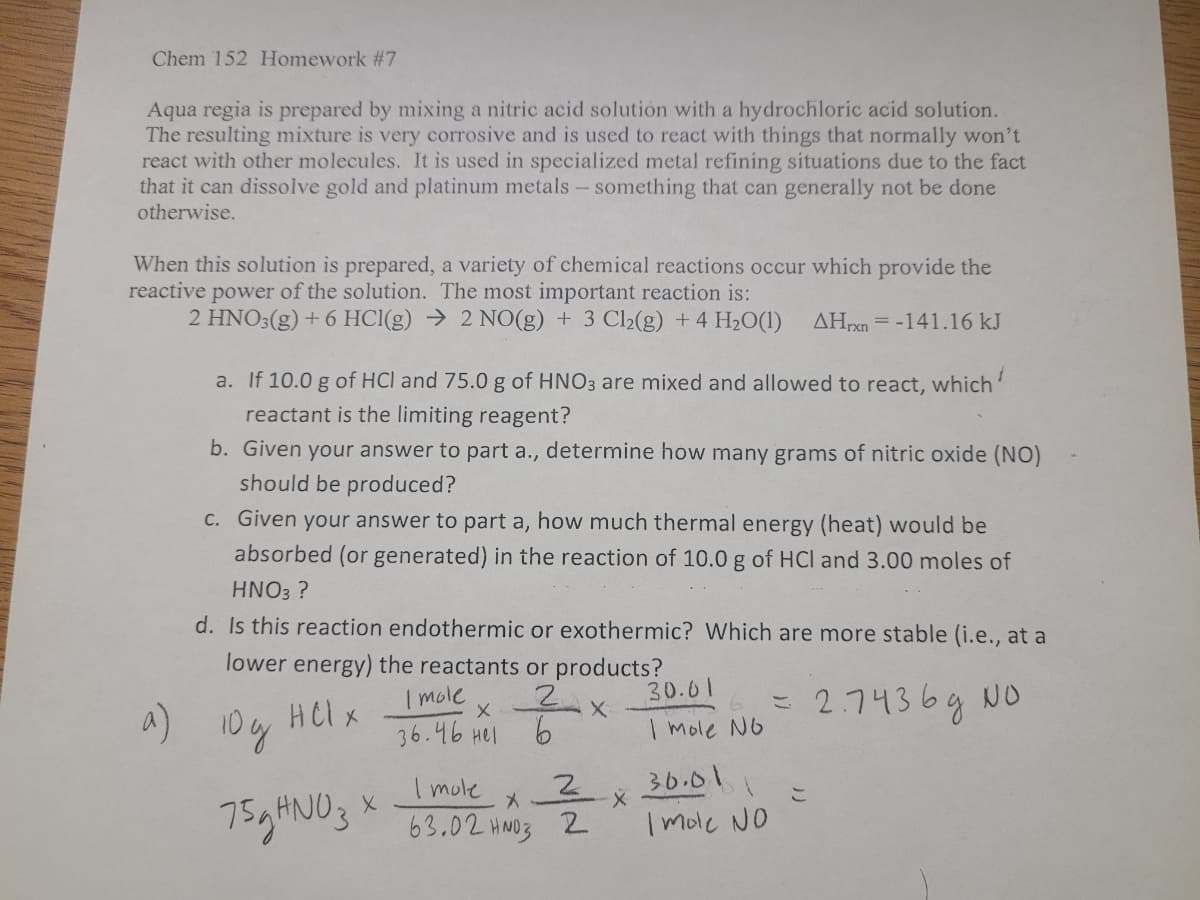Aqua regia is prepared by mixing a nitric acid solution with a hydrochloric acid solution. The resulting mixture is very corrosive and is used to react with things that normally won't react with other molecules. It is used in specialized metal refining situations due to the fact that it can dissolve gold and platinum metals- something that can generally not be done otherwise. When this solution is prepared, a variety of chemical reactions occur which provide the reactive power of the solution. The most important reaction is: 2 HNO3(g) + 6 HCl(g) → 2 NO(g) + 3 Cl2(g) +4 H20(1) AHrxn =-141.16 kJ a. If 10.0 g of HCl and 75.0 g of HNO3 are mixed and allowed to react, which' reactant is the limiting reagent?
Aqua regia is prepared by mixing a nitric acid solution with a hydrochloric acid solution. The resulting mixture is very corrosive and is used to react with things that normally won't react with other molecules. It is used in specialized metal refining situations due to the fact that it can dissolve gold and platinum metals- something that can generally not be done otherwise. When this solution is prepared, a variety of chemical reactions occur which provide the reactive power of the solution. The most important reaction is: 2 HNO3(g) + 6 HCl(g) → 2 NO(g) + 3 Cl2(g) +4 H20(1) AHrxn =-141.16 kJ a. If 10.0 g of HCl and 75.0 g of HNO3 are mixed and allowed to react, which' reactant is the limiting reagent?
Chemistry & Chemical Reactivity
10th Edition
ISBN:9781337399074
Author:John C. Kotz, Paul M. Treichel, John Townsend, David Treichel
Publisher:John C. Kotz, Paul M. Treichel, John Townsend, David Treichel
Chapter21: The Chemistry Of The Main Group Elements
Section: Chapter Questions
Problem 118IL
Related questions
Question
I need help with a)

Transcribed Image Text:Chem 152 Homework #7
Aqua regia is prepared by mixing a nitric acid solution with a hydrochloric acid solution.
The resulting mixture is very corrosive and is used to react with things that normally won't
react with other molecules. It is used in specialized metal refining situations due to the fact
that it can dissolve gold and platinum metals- something that can generally not be done
otherwise.
When this solution is prepared, a variety of chemical reactions occur which provide the
reactive power of the solution. The most important reaction is:
2 HNO3(g) + 6 HCI(g) → 2 NO(g) + 3 Cl2(g) + 4 H20(1)
ΔΗΚ
= -141.16 kJ
a. If 10.0 g of HCl and 75.0 g of HNO3 are mixed and allowed to react, which'
reactant is the limiting reagent?
b. Given your answer to part a., determine how many grams of nitric oxide (NO)
should be produced?
C. Given your answer to part a, how much thermal energy (heat) would be
absorbed (or generated) in the reaction of 10.0 g of HCl and 3.00 moles of
HNO3 ?
d. Is this reaction endothermic or exothermic? Which are more stable (i.e., at a
lower energy) the reactants or products?
I mole
36.46 Hel
30.01
こ 274364 o
Helx
4) 10y
9.
I mole N6
I mole
36.01
こ
759HNO3 * 3.02 Has 2
Imole NO
Expert Solution
Step 1
The balanced reaction given is,

a) Given: Mass of HCl taken = 10.0 g.
And mass of HNO3 taken = 75.0 g.
Trending now
This is a popular solution!
Step by step
Solved in 2 steps with 1 images

Knowledge Booster
Learn more about
Need a deep-dive on the concept behind this application? Look no further. Learn more about this topic, chemistry and related others by exploring similar questions and additional content below.Recommended textbooks for you

Chemistry & Chemical Reactivity
Chemistry
ISBN:
9781337399074
Author:
John C. Kotz, Paul M. Treichel, John Townsend, David Treichel
Publisher:
Cengage Learning

Chemistry & Chemical Reactivity
Chemistry
ISBN:
9781133949640
Author:
John C. Kotz, Paul M. Treichel, John Townsend, David Treichel
Publisher:
Cengage Learning

Chemistry by OpenStax (2015-05-04)
Chemistry
ISBN:
9781938168390
Author:
Klaus Theopold, Richard H Langley, Paul Flowers, William R. Robinson, Mark Blaser
Publisher:
OpenStax

Chemistry & Chemical Reactivity
Chemistry
ISBN:
9781337399074
Author:
John C. Kotz, Paul M. Treichel, John Townsend, David Treichel
Publisher:
Cengage Learning

Chemistry & Chemical Reactivity
Chemistry
ISBN:
9781133949640
Author:
John C. Kotz, Paul M. Treichel, John Townsend, David Treichel
Publisher:
Cengage Learning

Chemistry by OpenStax (2015-05-04)
Chemistry
ISBN:
9781938168390
Author:
Klaus Theopold, Richard H Langley, Paul Flowers, William R. Robinson, Mark Blaser
Publisher:
OpenStax

Chemistry: The Molecular Science
Chemistry
ISBN:
9781285199047
Author:
John W. Moore, Conrad L. Stanitski
Publisher:
Cengage Learning

Chemistry
Chemistry
ISBN:
9781305957404
Author:
Steven S. Zumdahl, Susan A. Zumdahl, Donald J. DeCoste
Publisher:
Cengage Learning

Chemistry: An Atoms First Approach
Chemistry
ISBN:
9781305079243
Author:
Steven S. Zumdahl, Susan A. Zumdahl
Publisher:
Cengage Learning